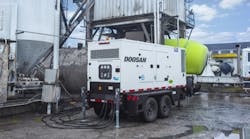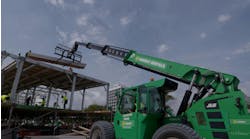The Participants:
- John Gibbons, general manager, NA rental business, Cummins Power Generation
- Bridget Kidd, director of residential & commercial programs, Propane Education & Research Council
- Ben Froland, product manager, Magnum Power Products
- Todd Howe, global generator products manager, Doosan Portable Power
- Manny Rumao, marketing manager, portable products, Kohler Power Systems
What is new in generator technology both at your company and in the generator industry as a whole?
Gibbons: The newest thing is that we’ve moved out of Tier 4 Interim and into Tier 4 Final, and various manufacturers are achieving that EPA mandate by different means. From a cost standpoint, the new Cummins Tier 4 Final products are slightly higher in cost, but by eliminating the diesel particulate filter we have a system that is virtually maintenance free and saves over the long run. The Cummins system also eliminates the possibility of shutdowns due to DPF clogging.
Howe: We’ve gone from Tier 3 to 4 interim and now from 4 interim to 4 Final. Along the way, we’ve done what we can to address customer need and innovate a little bit on some features and benefits as a result of that work. Most manufacturers that we’re in the market with would agree that it’s been very regulatory focused over the last few years. But as we look into the future we see a whole lot of pent-up opportunities for us to go back and revisit customer requirements and coming up with the next set of trends and specifications that will start driving the industry in the future.
Probably the biggest thing that’s going to come along here in the near term is very widespread adoption of remote telematics as the machines get more complex. So the ability to monitor and ultimately predict a machine that’s going to need some attention ahead of it actually having a failure is going to be where that frontier takes us over the next couple of years.
Froland: The most significant change in generator technology is certainly the transition to Final Tier 4 emissions engines. On smaller generators, the change may be nearly transparent as those engines utilize a diesel oxidation catalyst only. On larger generators, the change will be much more noticeable with the addition of selective catalytic reduction, diesel particulate filter, or both to those engines. This new class of generators will boast an 80-percent reduction in nitrogen oxides from the previous tier.
Kidd: While PERC doesn’t manufacture generators, we’ve been integral in helping our OEM partners bring various forms of new propane-powered generator technology to market. Just recently, we provided Generac with funding for its brand new 15kW EcoGen standby generator that’s designed specifically for use with alternative energy systems in off-grid applications. The fact that this generator can operate on propane is extremely important, as off-grid homes and businesses will not typically have access to natural gas. More specifically to the rental market, we’ve worked with Kohler on the development of its new propane-powered mobile generator line. Three models have been introduced to date, ranging in power from 50 kVA to 125 kVA.
Rumao: We introduced our Tier 4 Final Kohler direct injection diesel engine in 2012 and we’re now using it on our new mobile generators, for construction sites, remote power in the mining and gas industries, and other temporary power needs. Our Tier 4 Final diesel engine offers greater power density, quiet performance, and emissions compliance without the use of a DPF, which decreases operating costs. In Nov 2013 at the Greenbuild trade show Kohler introduced the world’s first electronic fuel injected (closed-loop) 12.3 kW portable generator that saves up to 25 percent on fuel consumption and emissions compared to the equivalent carbureted version.
Additionally, our new Decision Maker 3500 controller offers a graphical interface with user-friendly displays and keypad functions, remote monitoring, and the capability to parallel two generators for greater power output.
How have generators in general improved their performance capability and functionality? Howe: There’s been some improvement that’s probably not as well publicized as the overall impact Tier 4 has had. We’re seeing certain applications and power nodes, we’re seeing a bit of a fuel economy improvement because of the improved characteristics of engine efficiency and engine fuel injection. And as we went through the development, we looked at the key things that customers are always asking us for. Certainly noise level on generators is a very strong customer concern and an attribute we try to manage so as we went through the evolution of basically re-designing packages from the ground up for Tier 4 we made sure that lower noise was in our plan and we were able to achieve that with some fairly innovative technology.
Larger units for instance I’d say at least in our portfolio everything 150 kW up to 250 kW has a dual compartment enclosure system right now, which is a fairly innovative solution. We separate the engine compartment from the cooling system with a baffle wall between them.
Rumao: There have been significant improvements in the fuel efficiency and emissions of the engines powering generators. All new diesel engines must adhere to Tier 4 Final emissions standards, so engine manufacturers have made major design changes to achieve compliance. Control interfaces have also become much more visual, making the operation and monitoring of generators more intuitive than ever. Looking ahead, alternative fuels will continue to grow in demand as equipment operators look to run as efficiently and environmentally responsible as possible.
Gibbons: We are constantly working to make our generator sets run a little quieter, perform a little better and offer more flexibility for various applications. We have developed rental packages to take care of the current oil and gas boom, for example. We have a lot of units in the oil patches in North Dakota, Canada, Oklahoma and Texas. As a result, we’ve developed more cold weather and extreme service packages to go on our base units. We haven’t created an entirely new spec, but we’ve modified our existing units and added such things as diesel-fired heaters, heated crankcase ventilation systems and heater fuel modules and extended oil-change systems – everything users need for a remote mining or oil and gas operation that needs longer service intervals and needs to run at minus 40 F.
Cummins has improved fuel efficiency as much as 7 percent on some of our engines, getting more horsepower out of the same fuel input. That’s important for customers who usually bear those costs. On our Tier 4 Final web site, users can calculate the cost of diesel fuel and DEF for a given generator, load and runtime. This shows users that they are still saving money with the new Tier 4 Final machines as compared to the Tier 3 machines.
We’ve made paralleling very easy on our rental generators so that two 200 kW machines can become a 400 kW unit. It allows the end user, who may not want to invest in a 400 kW machine, to buy two 200 kW machines, and still go after larger projects. On future Tier 4 Final units, paralleling functions will be standard on our rental units down to about 150 kW, and optional at some units below that size.
Kidd: Environmentally speaking, propane is a cleaner-burning, lower-carbon fossil fuel than other petroleum-based products. That’s not just good for the environment—it’s also good for construction workers and bystanders who can breathe easier thanks to improved air quality on jobsites or at events. Furthermore, because propane vaporizes at atmospheric pressure, it’s virtually impossible to spill, minimizing the possibility of soil contamination.
Froland: While the new engine emissions tier has brought some additional complexity, it has also ushered in a new era of performance for mobile generators. Variable geometry turbos enable engines to respond to block loading faster than ever before. Service intervals have been doubled in many cases and power from a given displacement is higher than ever.
Another significant area of improvement is in generator controls. This was a major focus for Magnum with the introduction of our Power Zone controller. A large, 7-inch color display provides intuitive graphics and analog style gauges for easy operation by the end user.






